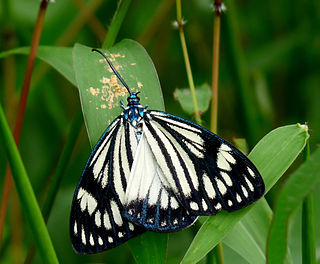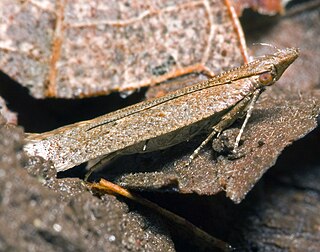
The Zygaenidae moths are a family of Lepidoptera. The majority of zygaenids are tropical, but they are nevertheless quite well represented in temperate regions. Some of the 1000 or so species are commonly known as burnet or forester moths, often qualified by the number of spots, although other families also have 'foresters'. They are also sometimes called smoky moths.

The Gelechiidae are a family of moths commonly referred to as twirler moths or gelechiid moths. They are the namesake family of the huge and little-studied superfamily Gelechioidea, and the family's taxonomy has been subject to considerable dispute. These are generally very small moths with narrow, fringed wings. The larvae of most species feed internally on various parts of their host plants, sometimes causing galls. Douglas-fir (Pseudotsuga) is a host plant common to many species of the family, particularly of the genus Chionodes, which as a result is more diverse in North America than usual for Gelechioidea.

Nepticulidae is a family of very small moths with a worldwide distribution. They are characterised by eyecaps over the eyes. These pigmy moths or midget moths, as they are commonly known, include the smallest of all living moths, with a wingspan that can be as little as 3 mm in the case of the European pigmy sorrel moth, but more usually 3.5–10 mm. The wings of adult moths are narrow and lanceolate, sometimes with metallic markings, and with the venation very simplified compared to most other moths.
The Tineodidae or false plume moths are a family of moths with in some cases unusually modified wings: Like in some related moths, the wings of several Tineodidae are decomposed into several rigid spines. This is a small family, with about a global total of 20 species described to date; some undescribed species are known or suspected to exist however. They seem to be of Australian origin, where they are most diverse, but range through the Wallacea to Southeast and South Asia, and into the Pacific to the Marquesas Islands.

Sufetula is a genus of moths of the family Crambidae.

Trichophysetis is a genus of moths of the family Crambidae.

Cybalomiinae is a subfamily of the lepidopteran family Crambidae. It was described by Hubert Marion in 1955.
Trichophysetis bipunctalis is a moth in the family Crambidae. It is found in China.
Trichophysetis cretacea, the jasmine bud borer, is a moth in the family Crambidae described by Arthur Gardiner Butler in 1879. It is found in Japan, Russia and China.
Trichophysetis crocoplaga is a moth in the family Crambidae. It is found in Australia, where it has been recorded from Queensland.
Trichophysetis fulvifusalis is a moth in the family Crambidae. It is found in Australia, where it has been recorded from Queensland.
Trichophysetis hampsoni is a moth in the family Crambidae. It is found in China.
Trichophysetis metamelalis is a moth in the family Crambidae. It is found in India.
Trichophysetis microspila is a moth in the family Crambidae. It is found on Sumbawa.
Trichophysetis nigridiscalis is a moth in the family Crambidae. It is found in India.
Trichophysetis nigripalpis is a moth in the family Crambidae. It is found in India.
Trichophysetis poliochyta is a moth in the family Crambidae. It is found in Australia, where it has been recorded from Queensland.
Trichophysetis preciosalis is a moth in the family Crambidae. It is found on La Réunion.

Trichophysetis umbrifusalis is a moth in the family Crambidae described by George Hampson in 1912. It is found in India.
Sufetula trichophysetis is a moth in the family Crambidae. It was described by George Hampson in 1912. It is found in Ghana.





